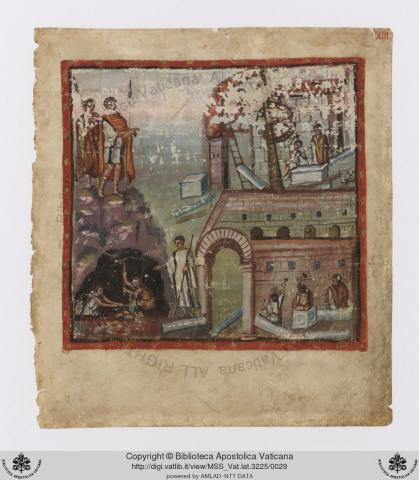Annotations
F: Fulvii Ursini schedae Bibliothecae Vaticanae (Vaticanus Latinus 3225), also known as the Vergilius Vaticanus or "Vatican Vergil." A magnificent illustrated codex written in Italy in rustic capitals at the end of the fourth or the beginning of the fifth century AD. The surviving 75 leaves contain parts of the Georgics and scattered sections from throughout the Aeneid. Originally it would have included the complete Eclogues, Georgics, and Aeneid. 50 illustrations survive (see Wright 2011, full text at Google Books) out of an original total of around 280. Though the text contains many errors it nonetheless preserves some readings of great importance (Conte 2011, x), and is the one of the oldest surviving sources for the text of the Aeneid.
Online Resources
Subjects
Type
Image
Properties
Date
early 5th c. AD
Medium
Dimensions
25 X 43 cm
Location
Vatican City, Biblioteca Apostolica
Image Credit


Wright 1993, 1-2:
"The Vatican Vergil is the most important surviving ancient example of an illustrated book of classical literature. We have several early illustrated biblical manuscripts, but the Vatican Vergil, having been made in Rome within a couple of decades of the year 400, is older than all but one of these, and because of its classical contents it draws on still older traditions. We also have a few ancient illustrated scientific texts, but they necessarily allow only a limited range of artistic expression. For illustrated classical literature we have only two other ancient manuscripts, both from later in the fifth century: the Ambrosian Iliad is a sadly damaged set of miniatures cut out of a book once generally comparable in character to the Vatican Vergil, while the Codex Romanus of Vergil is a large and pretentious book, but it has carelessly painted illustrations that in many aspects suggest the transition from classical to medieval bookmaking. Therefore a close study of the Vatican Vergil offers our best opportunity to find out how a fine illustrated book was made in classical antiquity, how it embodied long-standing traditions of classical art.
"This study must be undertaken carefully, with great patience. First there is the problem of the sad condition of our book (now Vat. lat. 3225 in the Vatican Library). Its seventy-five surviving folios are scattered fragments, sometimes a single leaf, sometimes a cluster of four or five successive leaves; they now contain fifty illustrations, some of them badly damaged. But from these fragments it is easy to reconstruct the form of the original book. It must have contained, as was customary at the time, all the canonical works of Vergil but no introductions or other accessory texts, and so it comprised about 440 folios bound in one volume. Extrapolating from the surviving illustrations and the traces of pigment from lost paintings, we can conclude that there were about 280 illustrations. The book was a precious copy of Vergil, fully illustrated but reasonably handy in size, made to be read and enjoyed. Where we have a relatively well-preserved group of successive folios we can appreciate directly the character of the book, but we must take a deliberate effort to imagine it in perfect condition and in its full original extent.
"A fine book of this kind was still a fairly new invention when the Vatican Vergil was produced; indeed, no surviving book of comparable quality is significantly older. Previously the standard form of book had been the papyrus roll, but that form had serious disadvantages, especially for the luxury market. Each book of the Aeneid or of the Georgics required a separate roll, while all ten Eclogues could be written on one roll. A reader unrolled the roll from the right hand into the left while reading columns of text, and then rolled it back up before putting it away. Papyrus has a relatively rough surface that absorbs ink well and also holds pigments reasonably well, but it was much less appropriate than parchment for fine books. Papyrus is also relatively fragile, and therefore with constant use a roll would wear out rather quickly. A luxury roll could be made of parchment, but all the unrolling and rerolling hastened the process of causing the pigments of an illustration and even the ink of the text to flake off the smooth polished surface of the parchment. Once it was invented, the new codex form—our normal book—had enormous advantages, not only because it made handling easier, allowing a reader to turn quickly to a particular passage, but also because it permitted much more elaborate paintings. The heavy application of pigment for an elaborately decorated frame or a fully painted background, impractical in a roll, could now be used to make book illustrations that in style are miniature versions of the wall paintings known from Pompeii and Rome."